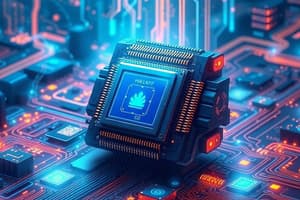Podcast
Questions and Answers
What is the primary function of the Control Unit in a CPU?
What is the primary function of the Control Unit in a CPU?
- Interact with I/O devices
- Perform arithmetic and logical operations
- Retrieve and decode instructions (correct)
- Store data temporarily
What type of memory is used to store data and programs when not in use?
What type of memory is used to store data and programs when not in use?
- Secondary Storage (correct)
- Registers
- Cache Memory
- Main Memory
What is the purpose of the Instruction Set Architecture (ISA)?
What is the purpose of the Instruction Set Architecture (ISA)?
- To manage the computer's memory hierarchy
- To define the syntax and semantics of instructions (correct)
- To optimize the CPU's execution cycle
- To design the CPU's control unit
What is the first step in the CPU execution cycle?
What is the first step in the CPU execution cycle?
What is responsible for performing arithmetic and logical operations in a CPU?
What is responsible for performing arithmetic and logical operations in a CPU?
What is an example of an Input/Output (I/O) Device?
What is an example of an Input/Output (I/O) Device?
What is the primary function of Cache Memory?
What is the primary function of Cache Memory?
What is Multiprocessing?
What is Multiprocessing?
What is the Cache Hierarchy?
What is the Cache Hierarchy?
What does Instruction Per Clock (IPC) measure?
What does Instruction Per Clock (IPC) measure?
What is the purpose of Level 1 (L1) Cache?
What is the purpose of Level 1 (L1) Cache?
What is the primary function of DMA in an I/O system?
What is the primary function of DMA in an I/O system?
What is the main advantage of parallel processing?
What is the main advantage of parallel processing?
What is the first stage in the pipelining process?
What is the first stage in the pipelining process?
What type of I/O interface is used for printer interfaces?
What type of I/O interface is used for printer interfaces?
What is the main characteristic of SIMD architecture?
What is the main characteristic of SIMD architecture?
What is the primary function of I/O interfaces?
What is the primary function of I/O interfaces?
What is the primary advantage of pipelining in CPU design?
What is the primary advantage of pipelining in CPU design?
Which component of a CPU is responsible for retrieving and decoding instructions?
Which component of a CPU is responsible for retrieving and decoding instructions?
What is the primary benefit of cache memory in a CPU?
What is the primary benefit of cache memory in a CPU?
What is a major challenge in CPU design?
What is a major challenge in CPU design?
What is the purpose of the Arithmetic Logic Unit (ALU) in a CPU?
What is the purpose of the Arithmetic Logic Unit (ALU) in a CPU?
What is a consideration in CPU design to minimize?
What is a consideration in CPU design to minimize?
Flashcards are hidden until you start studying
Study Notes
Computer Architecture Overview
- Study of the design and organization of computer systems
- Focuses on the way a computer's components interact and are organized
Components of a Computer System
- CPU (Central Processing Unit):
- Executes instructions and performs calculations
- Consists of:
- Control Unit: retrieves and decodes instructions
- Arithmetic Logic Unit (ALU): performs arithmetic and logical operations
- Registers: small amount of on-chip memory
- Memory:
- Main Memory: volatile, stores data and programs currently being used
- Secondary Storage: non-volatile, stores data and programs when not in use
- Input/Output (I/O) Devices:
- Allows users to interact with the computer
- Examples: keyboard, mouse, monitor, hard drive
Instruction Set Architecture (ISA)
- Defines the syntax and semantics of instructions that a CPU can execute
- Specifies:
- Instruction formats
- Instruction opcodes
- Operand formats
- Memory addressing modes
CPU Execution Cycle
- Fetch: retrieve an instruction from memory
- Decode: decode the instruction and determine the operation
- Operate: perform the required operation (e.g., arithmetic, load, store)
- Store: store the results of the operation
Performance Metrics
- Clock Speed (GHz): measures the rate at which a CPU can execute instructions
- Instruction Per Clock (IPC): measures the number of instructions executed per clock cycle
- Cache Hit Ratio: measures the effectiveness of the cache memory
Parallel Processing
- Multithreading: multiple threads of execution within a process
- Multiprocessing: multiple CPUs or cores within a system
- Parallel Computing: simultaneous execution of multiple tasks
Cache Memory
- Small, fast memory that stores frequently accessed data
- Cache Hierarchy:
- Level 1 (L1) Cache: smallest and fastest cache, built into the CPU
- Level 2 (L2) Cache: larger and slower than L1 cache
- Level 3 (L3) Cache: shared among multiple CPUs in a multi-processor system
- Main Memory: largest and slowest storage
Studying That Suits You
Use AI to generate personalized quizzes and flashcards to suit your learning preferences.




